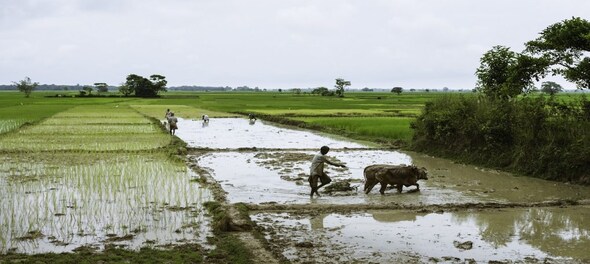
The first 10 days of July have witnessed a monsoon deficiency of 7 percent in the country, as per the India Meteorological Department (IMD) data.
Though some areas showed excess rainfall by the end of June, the break in the south-west monsoon in early June affected kharif sowing in many parts. Officials said that sowing in Maharashtra, Gujarat, Rajasthan, Haryana, and Punjab was less than normal.
The total acres of kharif crops where sowing happened at this point of time was around 49 to 50 million hectares, almost 11 percent less than 55 million hectares sown during the corresponding period in 2020, as per data from the agriculture ministry.
The total acres of rice sown was at 11 million as of July 10, 2021, (vis-à-vis the normal of 11.6 million hectares last year); and that for coarse cereals, which includes millets such as jowar, was roughly around 7.3 million hectares (vis-a-vis a normal of 8.7 million hectares last year), as per ministry’s data.
The total acres of cotton planted was at 8.6 million hectares (vis-a-vis 10.5 million hectares for the same period in 2020); soybean at 8.2 million hectares (vis-a-vis 9.2 million hectares in 2020); protein-rich pulse at 5.2 million hectares (against 5.3 million hectares in 2020).
India is the world’s largest sugar producer and sugarcane planting was normal at 5.3 million hectares.
Timely rainfall is crucial for one of Asia’s largest economies because around 50 percent of the population depends on agricultural or linked income. Nearly 60 percent of the country’s net-sown region does not have access to irrigation. More than 100 nationally important reservoirs, which provide potable water, power supply and irrigation, depending on rain.
The IMD has forecast normal rainfall (94 to 106 percent of the long period average or LPA) for July and monsoon should pick up by mid-July.
Many parts in north India, including Delhi and nearby areas experienced rain later than the dates predicted by the IMD.
The actual cumulative rainfall across India at 223 mm (from July 1 to 9) vis-a-vis a normal of 234.5 mm, as per IMD data.
Regions such as east Madhya Pradesh, Punjab, east Rajasthan, west Rajasthan, parts of Gujarat region, Saurashtra, Kutch, Vidarbha, Madhya Maharashtra, Chhattisgarh, coastal Karnataka, and south interior Karnataka got lower than average rainfall, the data showed.
The rains turned deficient from June 21, as per IMD data. The week ending June 30, rainfall for the entire country was 30.2 percent below the LPA normal level.
In FY21, the agricultural sector posted 3.1 percent growth to buoy rural India's economy when most other sectors showed negative growth due to the pandemic.



